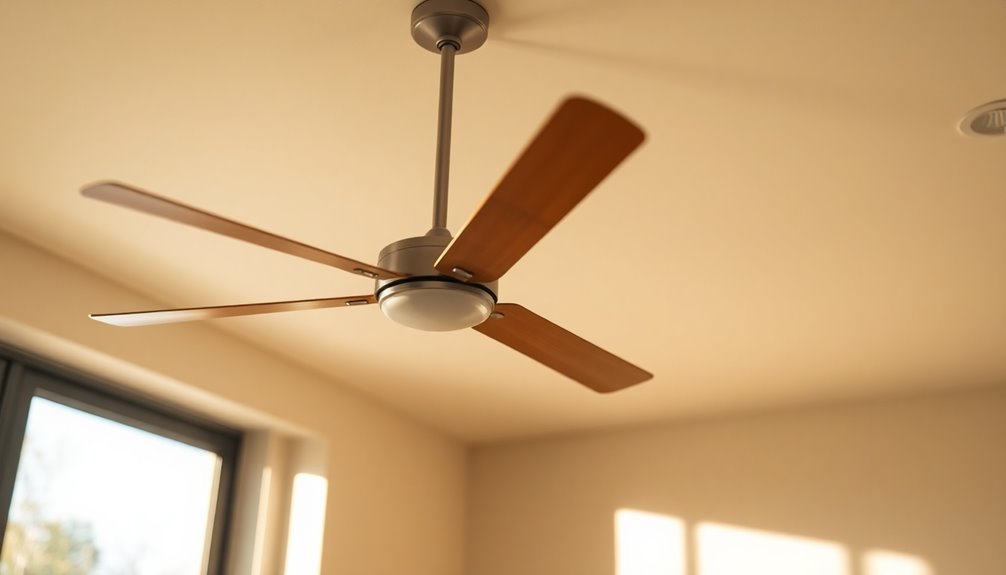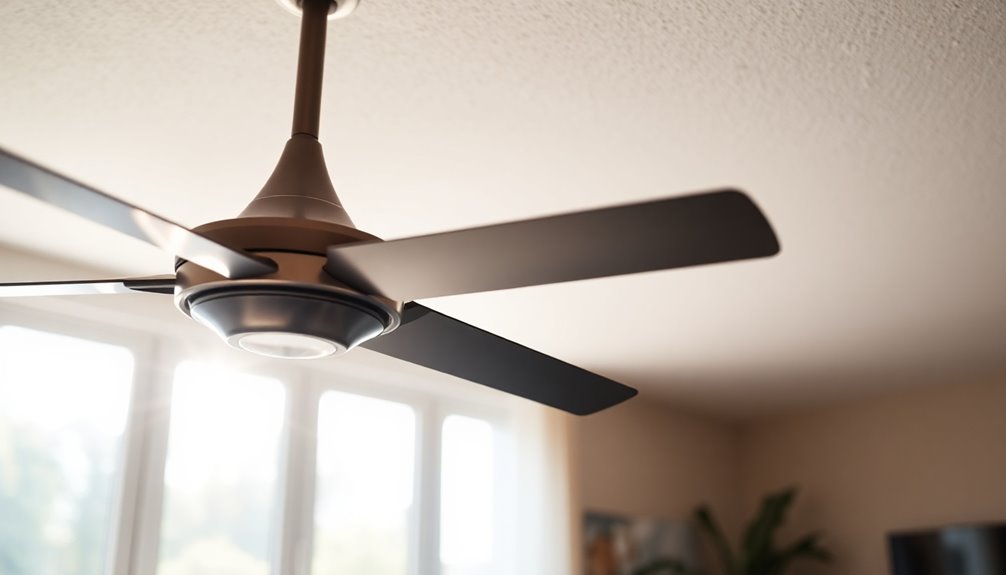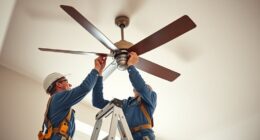Ceiling fan lighting options include integrated LED lights, light kits, and various bulb types like incandescent, CFL, and LED, allowing you to tailor your room’s ambiance and energy use. You can choose fixtures that match your decor, control brightness with dimmers, and enjoy smart features for added convenience. Proper installation and regular upkeep guarantee safety and performance. To optimize your fan’s lighting setup, explore the latest trends and tips—you’ll discover more to suit your needs.
Key Takeaways
- Explore different lighting types like integrated LEDs, light kits, and bulb options (incandescent, CFL, LED).
- Understand how ceiling fan lights operate, including fixture design, bulb technology, and control features.
- Consider factors like bulb type, fixture style, lumens, and smart controls to optimize lighting performance.
- Compare LED, incandescent, and future trends such as smart lighting and adjustable color temperature.
- Maintain safety and efficiency through proper installation, regular cleaning, and choosing energy-efficient, compatible fixtures.
The Role of Lighting in Ceiling Fans
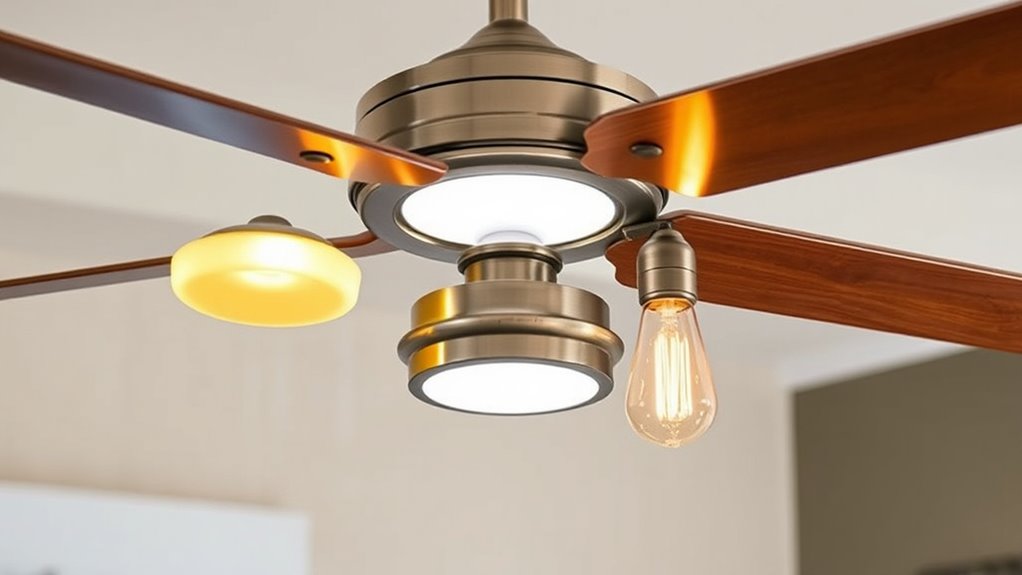
Have you ever considered how ceiling fan lighting can transform a room? This is where ceiling fan lighting plays a crucial role in enhancing illumination and ambiance. Modern fans feature integrated lighting with LED lights, offering energy-efficient illumination that uses up to 75% less power than traditional bulbs. Proper light fixture selection can also contribute to the overall safety and efficiency of your lighting setup. The right light fixtures allow you to customize brightness control and set the perfect mood. Adjusting light color temperature—from warm to daylight—can improve room aesthetics and functionality. Additionally, choosing compatible lighting options ensures seamless integration with your ceiling fan and enhances the room’s overall design cohesion. Proper lighting not only boosts visibility but also contributes to the aesthetic appeal and overall design cohesion of your space. Moreover, understanding lighting control systems can help create dynamic lighting environments tailored to different needs and occasions. Incorporating energy-efficient lighting can further reduce electricity costs and promote sustainability.
Types of Ceiling Fan Lights

There are several popular types of ceiling fan lights to contemplate, each offering different styles and functionalities to suit your needs. Integrated LED lights are sleek, energy-efficient, and built directly into the fan housing, providing a modern look with minimal clutter. Decoding slang Understanding informal language today can help you better interpret product descriptions and customer reviews. Light kits are attachable fixtures that you can customize in style and placement, giving you flexibility for various décor preferences. When considering bulb types, incandescent bulbs offer warm, natural illumination but are less efficient and have shorter lifespans. CFL bulbs are eco-friendly, consume less electricity, and work well with many light fixtures. LED lighting is another excellent choice, offering long-lasting, bright illumination from a reliable light source. These options allow you to tailor your ceiling fan’s lighting to match your style and energy efficiency goals. Additionally, considering lighting technology advancements during your selection process can help you choose options that provide better performance and longevity.
How Ceiling Fan Lights Work
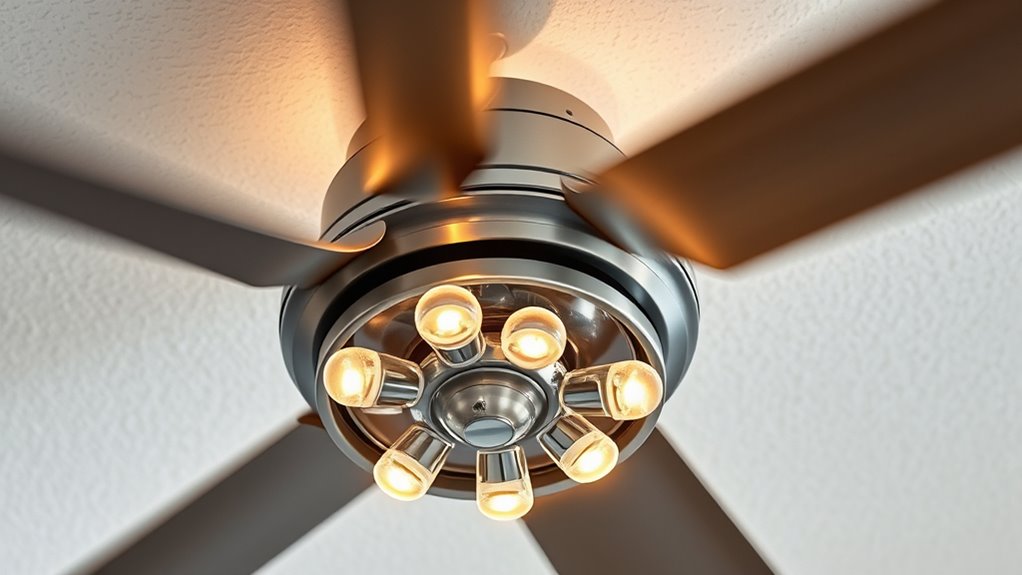
Ever wonder how ceiling fan lights produce the illumination you see? It all starts with the light fixtures, which house different bulb technologies like incandescent, CFL, or LED bulbs. These bulbs convert electrical energy into light, with LED bulbs offering superior light quality, energy efficiency, and longevity. Proper fixture design guarantees even light distribution, minimizing shadows and creating a comfortable ambient glow. The choice of bulb wattage influences brightness and heat output, which can affect fan motor performance. Modern systems often feature dimmable fixtures, allowing you to adjust brightness and color temperature for different moods. Smart lighting options enable remote or voice control, enhancing functionality and saving energy. Additionally, understanding the lighting options available can help you select fixtures that complement your room’s decor and improve overall ambiance. Selecting the right fixture design can also optimize light spread and aesthetic appeal.
Factors to Consider When Choosing Fan Lights

When choosing fan lights, it’s essential to think about the type of bulb, as this impacts energy efficiency, lifespan, and the room’s ambiance. Fan lights come with various lighting options, including LED, CFL, and incandescent bulbs, with LEDs offering up to 80% energy savings and longer life. Utilizing the best free keto diet app can be helpful in maintaining a balanced diet when planning meals that complement your lighting choices and overall room design. Match the light fixture style and finish to your décor—integrated LED lights provide a sleek, modern look, while traditional kits suit classic styles. Confirm the lighting provides enough lumens for your space, especially in larger rooms. Dimmable lights and adjustable color temperature let you customize ambiance easily. Also, consider smart controls or remote operation for convenience and seamless adjustments of both lights and fan speeds, enhancing your overall comfort. Being aware of state tax laws related to your retirement savings can help you plan your lighting and home upgrades efficiently without unexpected tax burdens. Additionally, understanding lighting regulations and standards ensures your installation complies with safety codes and energy efficiency requirements. Incorporating energy-efficient bulbs can further reduce your electricity usage and environmental impact. Moreover, choosing the right lighting setup can be an integral part of home automation strategies to improve energy management and convenience.
Pros and Cons of Different Fan Light Options

Choosing the right fan light depends on balancing your priorities for energy efficiency, style, and convenience.
Integrated LED lights offer sleek, energy-efficient illumination with minimal heat, making them ideal for savings and longevity. They are also popular in modern homes due to their low maintenance requirements and long lifespan. Additionally, LED technology continues to advance, providing even more options for customizable and sustainable lighting solutions.
Light kits provide flexibility in style and placement, letting you match your decor easily. This versatility allows homeowners to customize their lighting to suit different rooms and preferences.
Dimmable lighting enhances ambiance and allows brightness control, which can boost energy savings when paired with compatible dimmer switches. This feature is especially useful for creating different moods in living spaces.
Incandescent bulbs create warm, cozy light but consume more energy and generate more heat, whereas traditional bulbs are less efficient. Their nostalgic appeal remains for many homeowners despite the efficiency trade-offs.
Smart fans with lighting bring modern convenience, offering remote and voice control for customizable schedules and color temperature adjustments. These features align with the increasing integration of smart home devices into daily routines. As technology evolves, the incorporation of AI-powered features in lighting and fans can further enhance user experience and energy management.
Additionally, recent advancements in AI security research highlight the importance of developing robust safety measures to mitigate vulnerabilities and biases in AI-powered systems, ensuring safer integration across various sectors. Furthermore, ongoing research emphasizes the need for standardized safety protocols to ensure consistent protection standards in AI applications. Incorporating user-friendly interfaces can also improve accessibility for all users, fostering wider adoption of smart and AI-integrated lighting solutions.
Installing and Maintaining Ceiling Fan Lights

Installing and maintaining ceiling fan lights requires attention to safety and proper procedures to guarantee ideal performance. During installation, ensure wiring is secure, electrical connections are tight, and light fixtures are correctly positioned according to manufacturer instructions. Choose fixtures compatible with your fan model, whether integrated LED or attachable light kits, for seamless operation. When replacing bulbs, opt for energy-efficient LEDs to extend lifespan and reduce energy consumption. Use dimmer switches or smart controls compatible with your fixtures to adjust brightness and save energy. Regular maintenance involves cleaning light fixtures and bulbs to prevent dust buildup, inspecting wiring for wear or looseness, and checking electrical connections for safety. Additionally, selecting the right lighting fixtures can enhance both the functionality and aesthetic appeal of your space. Proper installation and routine upkeep keep your ceiling fan lighting safe, efficient, and visually appealing.
Energy Efficiency of Ceiling Fan Lighting
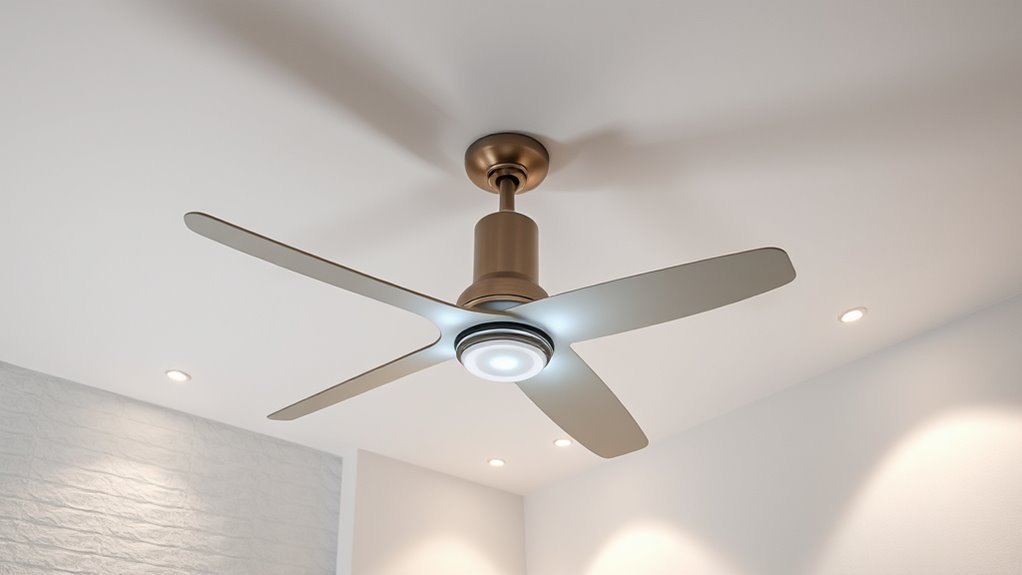
Switching to LED bulbs in your ceiling fan can cut energy use by up to 75%, saving you money over time.
Choosing ENERGY STAR-rated fixtures guarantees higher efficiency and lower heat output, which helps your fan run more smoothly.
Regularly replacing old bulbs with long-lasting, energy-efficient options keeps your costs down and extends fixture lifespan.
LED Vs Incandescent
Ever wondered how your ceiling fan’s lighting options affect your energy bills? LED bulbs use up to 75% less energy than incandescent bulbs, helping you save on utility bills.
While incandescent lights produce warm, inviting lighting, they’re far less energy-efficient, converting most energy into heat.
LEDs have a much longer bulb lifespan—up to 25,000 hours—meaning fewer replacements and less hassle.
Plus, LED lighting offers customizable brightness and color temperature, allowing you to create the perfect ambient lighting for any space.
Dimmable LED options give you control over brightness while maintaining high energy efficiency.
Switching to LED bulbs not only reduces your energy consumption but also enhances your overall lighting experience, making them a smart choice over traditional incandescent bulbs for ceiling fans.
Energy Saving Tips
To maximize the energy efficiency of your ceiling fan lighting, you should take advantage of simple tips that reduce unnecessary power consumption. Switch to LED bulbs, which use up to 75% less energy than incandescent bulbs, providing significant energy savings.
Install dimmer switches to adjust brightness and limit power use during low light needs. Choose ENERGY STAR-rated fans with integrated LED lighting for ideal energy efficiency and up to 60% savings over non-rated models.
Regularly clean light fixtures and fan blades to maintain proper light output and airflow, preventing energy waste caused by dust buildup. Use smart controls and schedule lighting to operate only when needed, avoiding unnecessary energy use.
These tips help you cut costs while maintaining effective illumination and comfort.
Bulb Lifespan
Choosing the right bulbs for your ceiling fan can substantially impact their lifespan and overall energy efficiency. LED bulbs, known for their long bulb lifespan, can last up to 25,000 hours, far exceeding incandescent or CFL options.
Energy-efficient lighting not only reduces power consumption by up to 75% but also minimizes heat stress, extending bulb durability. Proper installation and regular cleaning prevent dust buildup and overheating, further promoting lifespan extension.
Dimmable LEDs let you adjust brightness while lowering wear, helping to prolong bulb life. Selecting LEDs with higher lumen output and appropriate wattage guarantees peak performance without sacrificing efficiency.
When it’s time for bulb replacement, switching to durable LED fixtures ensures your ceiling fan remains bright, efficient, and long-lasting.
Tips for Enhancing Fan Light Performance

Enhancing your fan light performance begins with selecting the right bulbs and fixtures. Use energy-efficient LED bulbs, which cut energy use by up to 75% and produce minimal heat, keeping fan performance unaffected.
Choosing energy-efficient LED bulbs enhances fan light performance while reducing energy consumption.
Choose fixtures designed for maximum light distribution to prevent shadows and glare, ensuring even illumination. Installing dimmable light kits allows you to adjust brightness to suit different moods and reduce unnecessary energy consumption.
Regular bulb maintenance, like cleaning fixtures and bulbs, keeps brightness levels high and prevents dust buildup. For added convenience, opt for smart lighting options that let you control brightness and color temperature via remote or app.
These tips help maximize fan light performance, enhance ambiance, and improve energy efficiency effortlessly.
Future Trends in Ceiling Fan Lighting
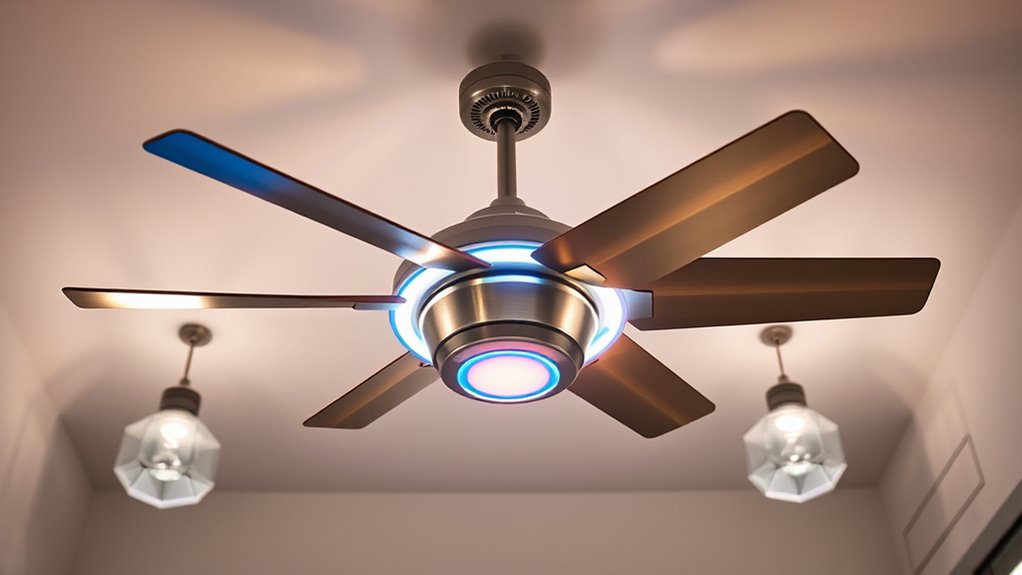
The future of ceiling fan lighting is driven by smart technology and innovative design trends that prioritize convenience, customization, and energy efficiency. You’ll see more smart lighting systems with wireless controls that seamlessly integrate into your smart home ecosystem, like Google Home or Alexa.
LED technology now offers customizable color temperature options from warm 2700K to daylight 6500K, allowing you to create the perfect ambiance. Adaptive lighting, which adjusts automatically based on time or occupancy sensors, enhances comfort and conserves energy.
Modern design emphasizes sleek, statement fixtures with integrated lighting solutions that blend aesthetics with energy efficiency. Expect automation to simplify your experience, giving you control over brightness, color, and fan speed remotely—making your space smarter, more stylish, and eco-friendly.
Frequently Asked Questions
Can Ceiling Fan Lights Be Used Independently of the Fan?
You might wonder if ceiling fan lights can run without the fan. Usually, it depends on the fixture’s wiring and switch setup.
Some fans have separate switches for lights and fans, allowing independent operation. Others require the fan to be on for the lights to work.
Check your fan’s wiring or switch configuration to see if you can turn on the lights alone.
Always follow safety guidelines or consult an electrician if unsure.
Are There Safety Concerns With Dimmable or Smart Fan Lighting?
You might wonder if dimmable or smart fan lighting poses safety risks. Generally, these lights are safe if installed correctly and rated for your fixture.
Dimming can cause flickering or overheating if incompatible bulbs or dimmers are used. Smart lighting requires proper wiring and compatible controls.
Always follow manufacturer instructions, verify secure connections, and use approved components to avoid electrical hazards and ensure safe operation.
How Do I Choose the Best Color Temperature for My Space?
Imagine your space as a canvas waiting for the perfect brushstroke. To choose the best color temperature, consider your mood and activities.
Warm tones (2700K-3000K) create cozy, inviting vibes, ideal for relaxation.
Cooler tones (4000K-5000K) energize and energize, perfect for workspaces.
Think about what feels right for your environment, and let your lighting paint a picture that suits your lifestyle perfectly.
What Are the Common Compatibility Issues With Smart Ceiling Fan Lights?
When you’re exploring smart ceiling fan lights, you might face compatibility issues. Common problems include mismatched smart home systems, such as Alexa or Google Assistant, which can prevent your lights from syncing properly.
You could also encounter issues with dimmer switches, outdated firmware, or incompatible bulbs. To avoid these, check the product specifications carefully, verify your existing setup supports the smart features, and keep your devices updated for seamless operation.
How Long Do Different Types of Ceiling Fan Bulbs Typically Last?
You wonder how long different ceiling fan bulbs last. Incandescent bulbs generally last around 1,000 hours, so you might need replacements every year if used daily.
LED bulbs are more durable, lasting up to 25,000 hours or more, making them a cost-effective choice.
CFLs fall somewhere in between, lasting about 8,000 to 10,000 hours.
Your choice depends on your preferred brightness and longevity.
Conclusion
Choosing the right ceiling fan lighting can truly transform your space, blending style and function effortlessly. As you explore different options, you’ll find that the perfect light not only enhances your room’s ambiance but also fits seamlessly into your daily routine. Remember, it’s often the small details—like the right bulb or fixture—that make all the difference. So, trust your instincts, and let your new fan lighting brighten your home in ways you never expected.


